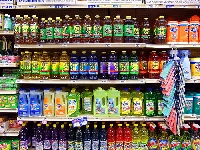How do cleaning products work
By Catalogs Editorial Staff

How do cleaning products work might be on your mind as you watch dirt disappear
We’ve all seen the ads for cleaning products and we know what they’re supposed to do – whiten, brighten, dig out grime, remove grease, get rid of grass stains! Surprisingly, many of them actually live up to their fantastic claims.Which begs the question: how do cleaning products work?
If you’re like me, when you spill some food or drink on your shirt or get a grass or oil stain on your pants, you quickly reach for whatever is available. In most cases, that’s water or saliva – we all remember Mom going into her purse for a tissue, wetting it and trying to blot away whatever you just got on your Sunday finest. Cleaning with plain water is a futile task because water can’t remove oil, which most stains and grime contain at least a little of, otherwise they’d just brush off.
The first cleaning product developed was soap. Soap works by emulsion, which means it combines two things into one. In this case, soap combines water and oil – two things we all know don’t mix – into a soapy grimy liquid. Once joined, soaking and agitating the clothing with more water, either by hand or sprayer or in a washing machine, will help remove the soapy-oily mix and hopefully the stain. As we’ve all disappointingly discovered, stains are tougher than soap.
Before you continue reading about the How do cleaning products work there is a special announcement we would like to share with you. Catalogs.com has negotiated special medicare rates for our vibrant community of seniors. If you are over the age of 60, you can head over to our Seniors Health Section which is full of information about medicare. All you need is your zip code and a few minutes of your time to potentially save 100s of dollars on your medicare bills.
~
When animal and vegetable fats used to make soap became scarce during the First and Second World Wars, scientists in the cleaning products industries turned to surficants – substances that reduce the surface tension between liquids. When surficants are added to water, the reduced surface tension makes it easier for water to bond with oil and grease, thus allowing the dirty stuff to be lifted from fabric and washed away.
Of course, you’ve heard the commercials and you know there’s plenty of other stuff added to detergents and cleaning products, often for specialized cleaning problems like kitchen pans or rugs. One popular additive is enzymes, which help break down stains containing proteins, like milk. Another cleaning additive is bleach. Besides being a powerful disinfectant and germ killer, bleach lightens stains while having no affect on bleach-resistant colors. Water helps a little too. Warm or hot water can melt some of the oils in stains and loosen them up for the other chemical additives to work.
As stains get tougher, the chemistry of cleaning gets a little more complicated. Although they’re made to remove oils, modern detergents are actually made from petroleum products! This allows them to bond more easily with the oils in dirt and stains. Many detergents have “oxy” in their names because they contain oxidizers – these are tougher forms of surficants that cause stronger chemical reactions between water and grime and can also whiten stains.
For the environmentally-conscious consumer, there are many products containing natural alternatives to these chemical products and most perform close to their counterparts in cleaning and removing stains. No matter which cleaning product you use, it’s always important to read the directions and warnings carefully on the label. Check the company’s website for additional information and don’t forget to ask others about their experiences. Especially Mom – she’s come a long way from those days of cleaning with spit and tissue!
Popular Savings Offers



.jpg)





.jpg)

